| Features |
|
| |
| |
|
|
| Columns |
| |
| |
| Departments |
|
| |
| |
|
| |
|
|

|
|
|
Rangefinder
Magazine
December 2002
Semyonovka by Malcolm Mathieson
The Passion of the Personal Portfolio
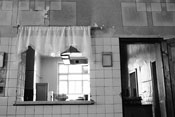 AS
A YOUNG AUSTRALIAN growing up in the ’60s and’70s, Russia
was an unknown and forbidden land. That was my memory—a memory of
reading Tolstoy and Solzhenitsyn; memories of the Cold War, the Russian
Red Army Choir, the Space Race and a people and place largely forbidden.
It was place we feared—a power like the U.S.A. but often painted
as place of danger, the great Soviet Union who aimed to control the world. AS
A YOUNG AUSTRALIAN growing up in the ’60s and’70s, Russia
was an unknown and forbidden land. That was my memory—a memory of
reading Tolstoy and Solzhenitsyn; memories of the Cold War, the Russian
Red Army Choir, the Space Race and a people and place largely forbidden.
It was place we feared—a power like the U.S.A. but often painted
as place of danger, the great Soviet Union who aimed to control the world.
Being raised in the Australian country, in a land of brown—the driest
continent on earth, dealing with an environment often ravaged by bushfires
and searing heat, Russia with its huge expanses of wilderness was like
Australia but the opposite—we are a hot dry land and Russia a land
of cold and snow. A place that brought visual images to the mind of endless
white, of trains plowing through snow, of fur hats and coats and, of course,
of music, ballet, literature and art.
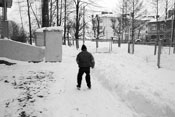 It was a dream to visit, and a dream realized in December last year when
within a space of a few short weeks of making a decision I found myself
on a train heading across Russia, having left Sydney, Australia 42 hours
prior. Once decided, a trip to Russia was not that difficult. Sure, a
visa had to be arranged, flights and trains booked and a reason to make
the trip worthwhile discovered. To me there was not much point realizing
a life-long dream if you cannot share it and at the same time use your
skills as a photographer to help communicate your view of this world to
as many others as possible.
It was a dream to visit, and a dream realized in December last year when
within a space of a few short weeks of making a decision I found myself
on a train heading across Russia, having left Sydney, Australia 42 hours
prior. Once decided, a trip to Russia was not that difficult. Sure, a
visa had to be arranged, flights and trains booked and a reason to make
the trip worthwhile discovered. To me there was not much point realizing
a life-long dream if you cannot share it and at the same time use your
skills as a photographer to help communicate your view of this world to
as many others as possible.
A project had to be found—and fast. I needed an excuse to spend
Christmas and New Years in Russia, a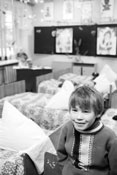
reason to do something. As a lecturer and speaker in the photographic
community, I speak about the power of photography to communicate, to change
people’s views, to educate and improve mankind—lofty subjects
but nonetheless, truth.
I had completed many exhibitions on my community and the people of a couple
of towns in Australia. I had raised money for charity by using my skills
as a photographer to document my society but it was time for a new challenge—time
for me to take a dose of my own medicine and do something as best as I
could for mankind. It was time to push myself out of my comfort zone.
It was a time for me to try and break down some barriers of ignorance,
both within myself and perhaps in those who would see the images, but
the question remained—what to photograph?
These days we have the Internet so a simple posting in a few newsgroups
asking for ideas of a photographic project was in order. My query brought
a flood of responses and one stood out—a visit and a photographic
record of an orphanage, but not just any of the many in Russia, but one
for mentally handicapped children—Semyonovka.
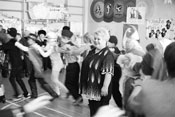 The
train pulled into the station and I stepped into a wall of cold air like
I had never felt. My translator, who was dressed like a mummy in a fur
coat and hat, greeted me. I looked a little out of place in the sea of
black furs in my purple Gortex, rucksack over one shoulder and Leica M6
camera, well covered, along with three lenses. I had put a lot of thought
into what equipment to take. I realized it would be often –35°
Celsius and colder. Batteries were going to die and indeed did. Film was
going to be brittle and as with all travel, weight was a major issue.
I also was aware as a long time Leica fan that small and quiet cameras
placed less of a barrier between me and the children and staff. It was
going to be hard to be unobtrusive. Russians rarely have beards—they
freeze, as I was about to discover—and they certainly do not speak
like an Australian. The last thing I needed was a big camera. The
train pulled into the station and I stepped into a wall of cold air like
I had never felt. My translator, who was dressed like a mummy in a fur
coat and hat, greeted me. I looked a little out of place in the sea of
black furs in my purple Gortex, rucksack over one shoulder and Leica M6
camera, well covered, along with three lenses. I had put a lot of thought
into what equipment to take. I realized it would be often –35°
Celsius and colder. Batteries were going to die and indeed did. Film was
going to be brittle and as with all travel, weight was a major issue.
I also was aware as a long time Leica fan that small and quiet cameras
placed less of a barrier between me and the children and staff. It was
going to be hard to be unobtrusive. Russians rarely have beards—they
freeze, as I was about to discover—and they certainly do not speak
like an Australian. The last thing I needed was a big camera.
I was instantly made at home and felt honored to share
time, meals and Christmas with my hosts.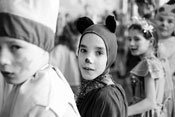
Semyonovka is an old building, home to 183 children, ages seven to 16,
plus a staff of over 130, of which 70 are teachers. It is a place filled
with laughter, and kids and more kids—they seemed to be everywhere
and then disappear to classes, meals and bed. One minute noise the next
quiet. It was an exciting time, Father Frost was to visit, no Santa here.
The annual party was to be held and perhaps they would get a gift. I had
stopped in Bangkok and purchased a heap of yo-yos and assorted things
for Father Frost. The Russian education budget is tight and feeding and
clothing the children, let alone teaching and housing, eats up the resources.
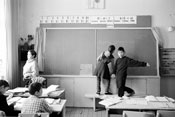 I
had almost complete freedom to come and go as I pleased, to photograph
everywhere and at any time. My aim was to get 30 images for exhibition
and to increase my ability to see and record. This was not the time for
lights, posing and control, I could not speak a word of Russian anyway
and few Russians speak English, none at the orphanage. It was a dark and
cold place, exposures at 1/15 and 1/8 of a second, handheld at f/1.4.
It was a great time—no client had commissioned me, no boss to answer
to, only the hardest taskmaster of all, myself. I
had almost complete freedom to come and go as I pleased, to photograph
everywhere and at any time. My aim was to get 30 images for exhibition
and to increase my ability to see and record. This was not the time for
lights, posing and control, I could not speak a word of Russian anyway
and few Russians speak English, none at the orphanage. It was a dark and
cold place, exposures at 1/15 and 1/8 of a second, handheld at f/1.4.
It was a great time—no client had commissioned me, no boss to answer
to, only the hardest taskmaster of all, myself.
I wanted to make these images the best I could. I visited for a few days,
photographed and tried to become part of the scene, not easy as within
a few minutes you were surrounded by kids, many wanting to hold your hands
and walk with you. But as time went by it got easier. I was accepted by
the kids and trusted. Images came easier. Kids were more natural. I stayed
away for a few days, and returned, my eyes seeing things I had missed
at first. I  walked
the place in different ways, looking for images that showed the loneliness
of a child without parents but the love and warmth of the staff. walked
the place in different ways, looking for images that showed the loneliness
of a child without parents but the love and warmth of the staff.
Tamara, the deputy director of Semyonovka a wonderful round and jolly
lady, herself with a disabled son and a staff member of 30 years, told
me of the children, broken homes—alcohol abuse being a major problem.
She told me of people not being able to care for their offspring and of
many that simply had lost their parents in a tragedy of one kind or another.
She explained that like all facilities, money is short; the average wage
being only $50 a month, and food is expensive. The kids work on their
own farm in summer and grow many of the vegetables. It is the Russian
way and one we can learn so much from.
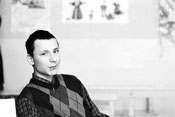 I
completed my pictures, had the film processed in town—18 rolls for
$4. I was not about to risk X-rays and so I headed home. I had changed
as a person, learning to see with my eyes and feel with my heart a little
more. The real skills as a photographer are not the ability to operate
a camera but to feel and record those feelings. I
completed my pictures, had the film processed in town—18 rolls for
$4. I was not about to risk X-rays and so I headed home. I had changed
as a person, learning to see with my eyes and feel with my heart a little
more. The real skills as a photographer are not the ability to operate
a camera but to feel and record those feelings. 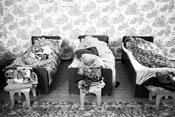
I left with Tamara’s words ringing in my ears—I had asked
her that if I could raise a few dollars what did she need? Her words,
“the kids would all like their own towel.”
Malcolm Mathieson is an internationally known photographer
and the current president of the WCPP, World Council of Professional Photographers.
He will be a featured speaker at WPPI 2003, to be held at BALLY’S
Las Vegas, Feb. 1–6. He will be presenting a platform program entitled,
“The Photographic Conscience,” and also a MasterClass workshop
entitled, “Exploiting Your Personal Photography.”
|








